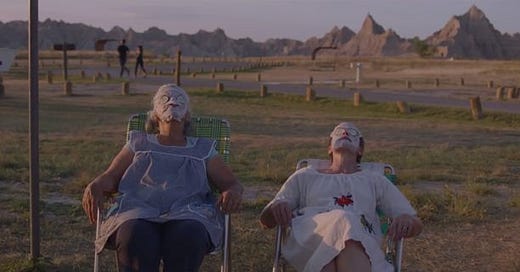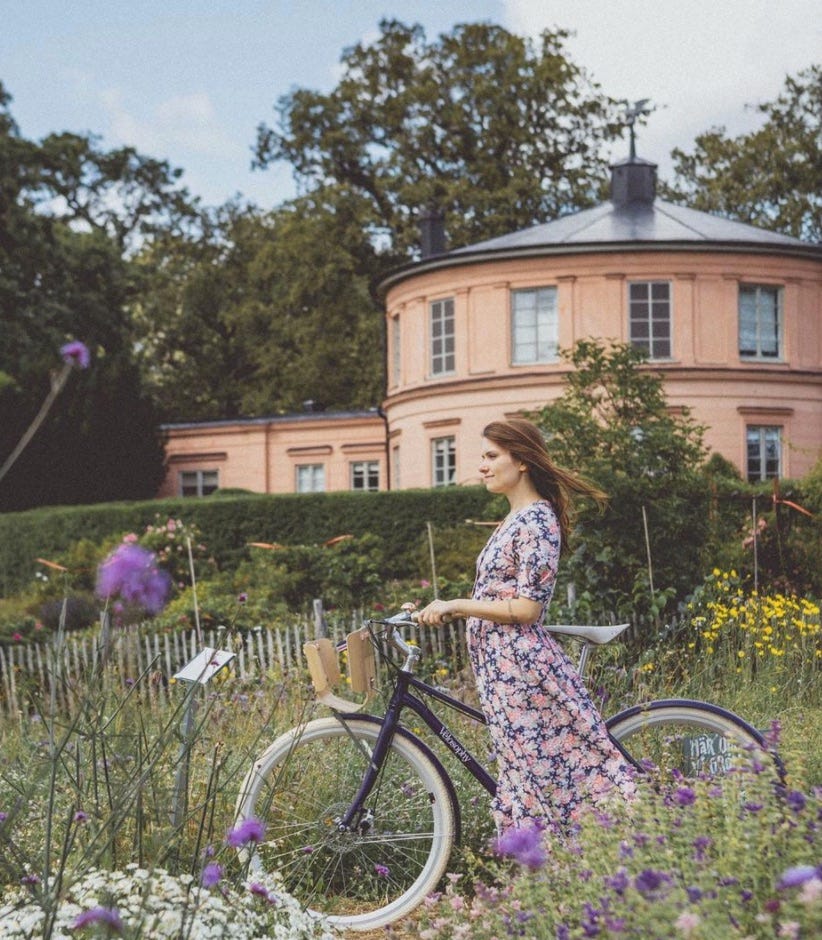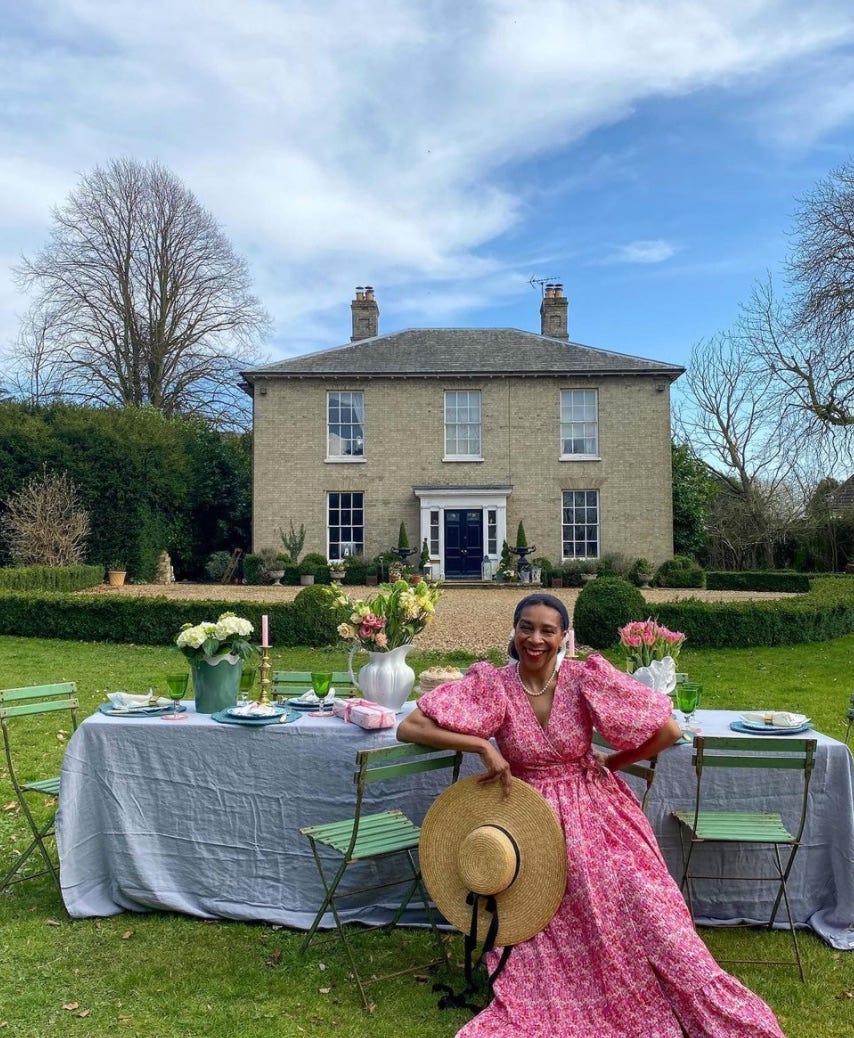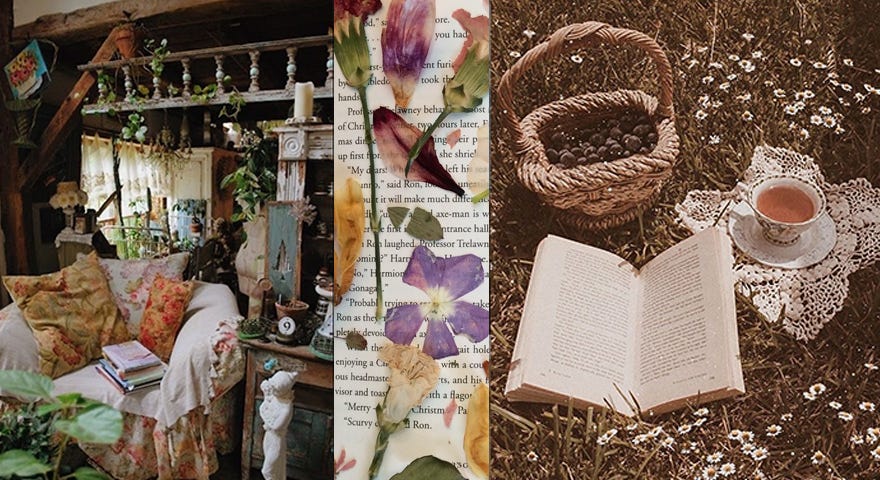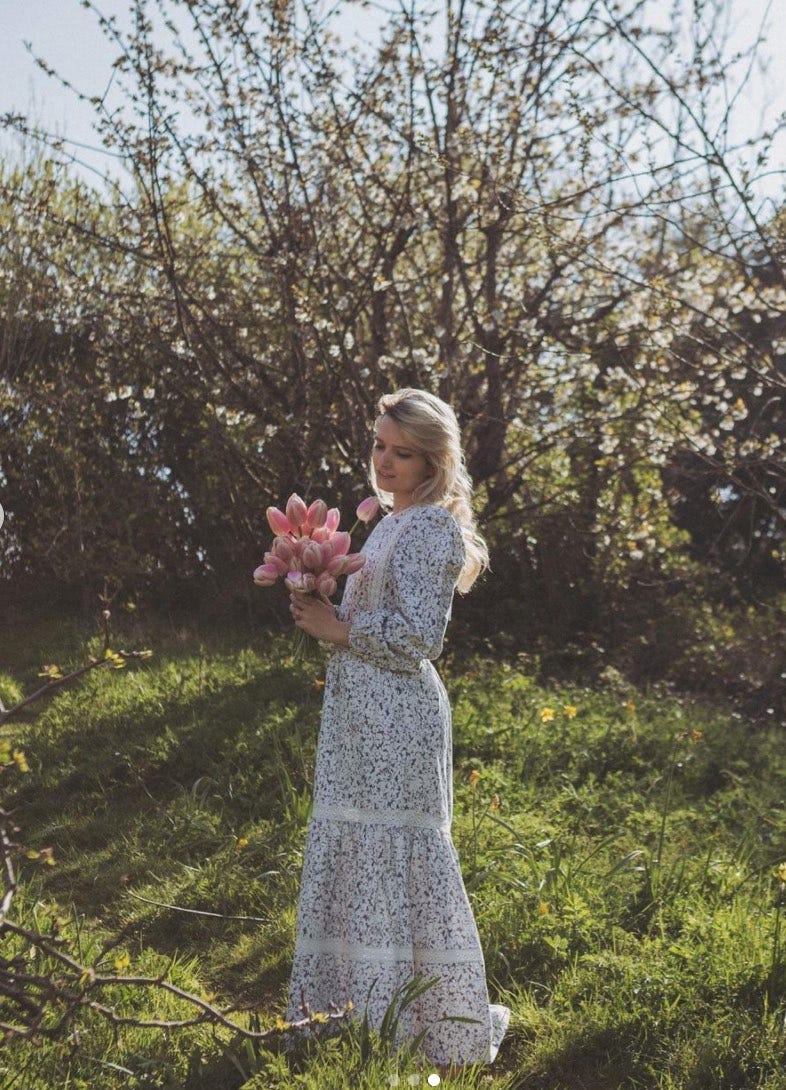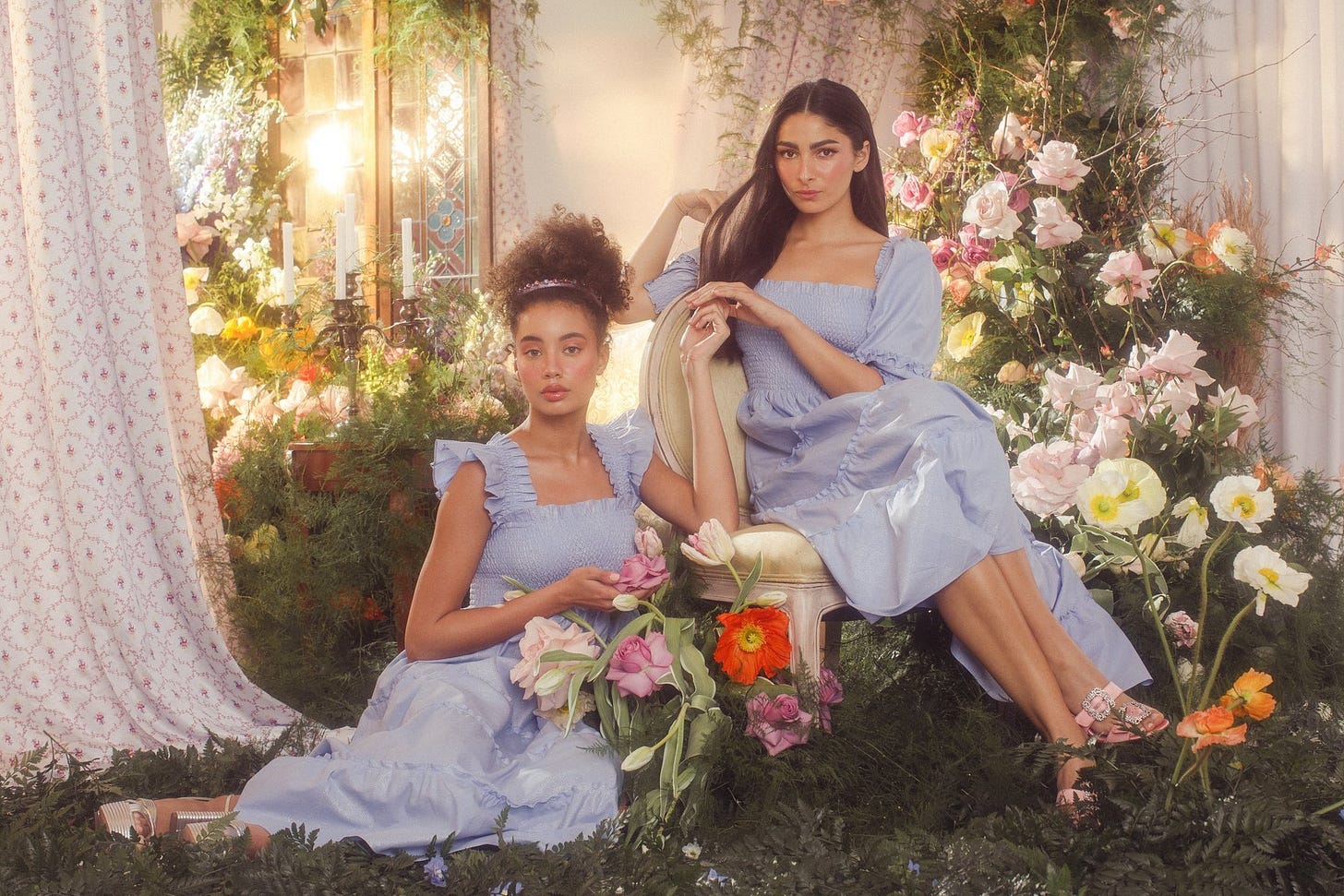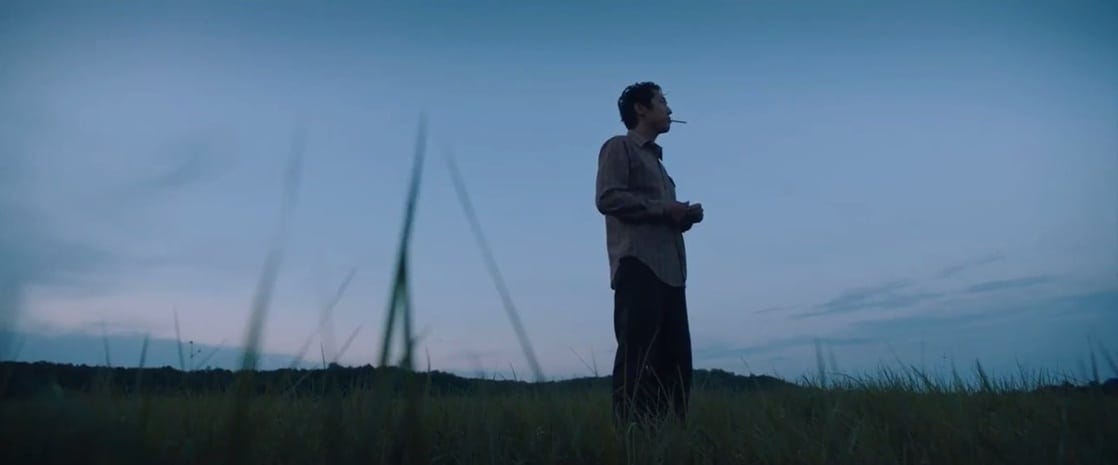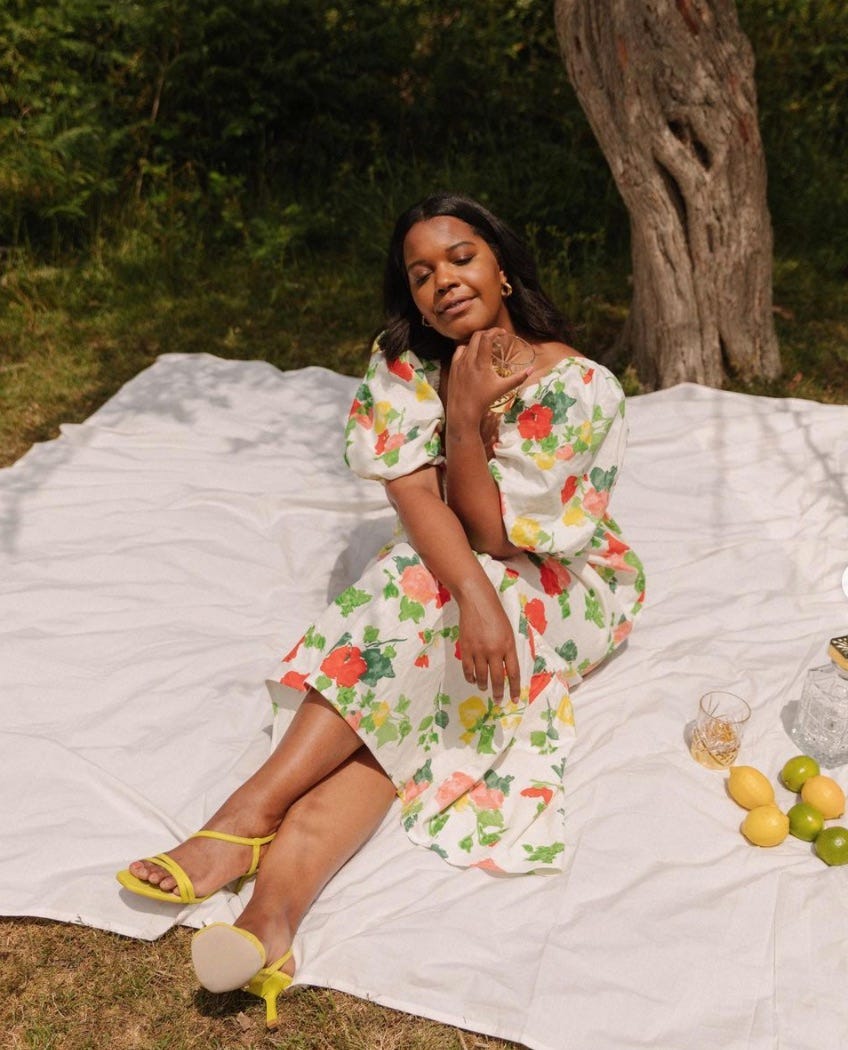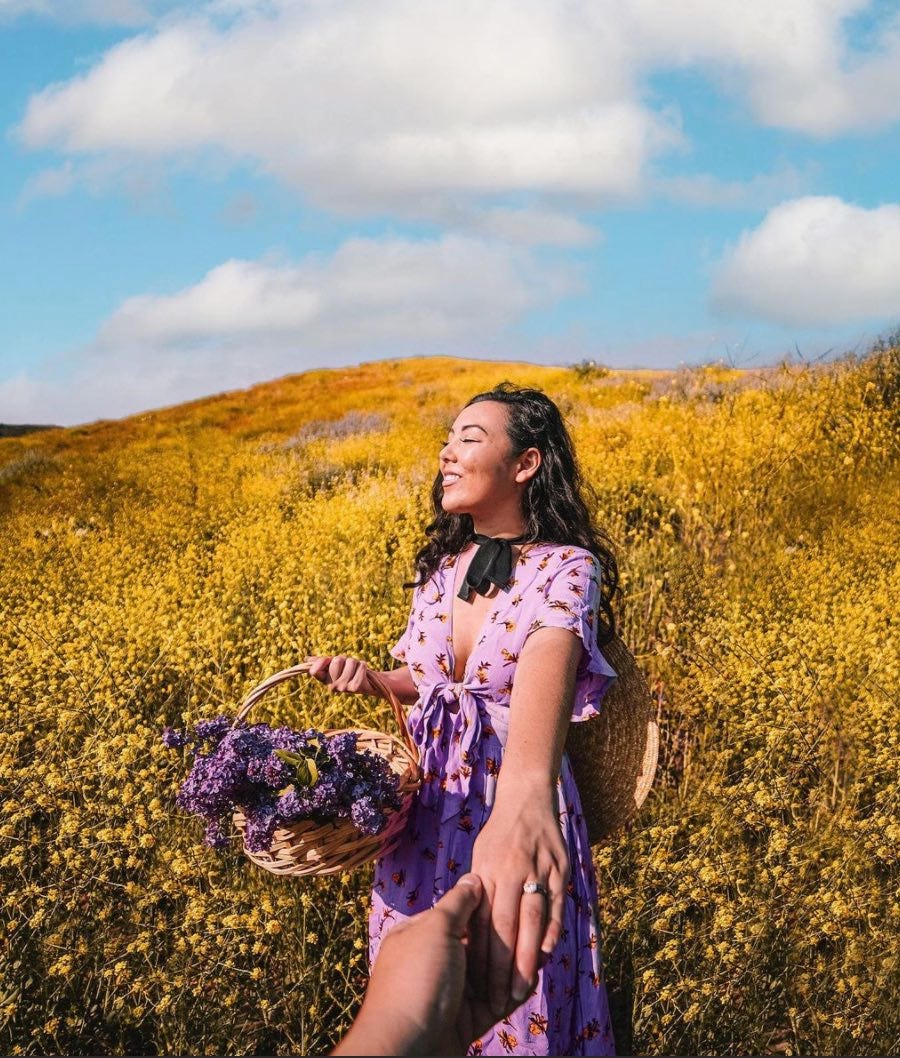mental health awareness month, but make it cottagecore
Mental Health Awareness Month is usually characterized online by the confessional Instagram or Facebook post about a celebrity or influencer’s struggles with a mental health diagnosis or temporary struggle. It typically follows a certain formula: safely divulging one’s mental health history without revealing too much as to claim it as an identity or open one up to scrutiny.
I could write a whole newsletter about my irritation with the desire to view mental health as something separate from other kinds of physical or mental or emotional fitness, as well as the bizarre and irritating euphemisms that come out of awareness month campaigns like this.
But in 2021, what I’m thinking about is anxiety, and fashion. My thoughts about mental health are tied up in one thing: cottagecore.
*
Cottagecore is, to me, an evolution of that hipster-y ironic love of Mad Men 50’s and 60’s vintage dresses and old school domesticity that I first glommed on to in the early 2010’s. This was an aesthetic that I loved and kind of still do if I’m honest. There’s something that felt deeply rebellious and subversive and cool about wearing a 50s housewife silhouette dress while also subscribing to contemporary evolving feminist ideas about intersectionality, representation, and social justice.
Taking the look of that time felt cool and edgy, but it came with that darker underside that comes with historical hindsight: Betty Friedan’s The Feminine Mystique followed up by her “lavender menace;” the suicides and suffering of women like Sylvia Plath, who faced abuse and a lack of mental healthcare support; Jim Crow laws and segregation were the law of the land; women had little to no access to contraception, abortion care, or even private medical services away from their husband’s prying eyes.
That is to say: when you take on the look of a previous era, you’re trying to subvert its darkness, but that darkness doesn’t leave just because the year is 2012 and you’re 22 years old (c’est moi).
I was inspired by Peggy Olsen’s swagger when leaving her job and Don Draper’s voiceover reading Frank O’Hara’s Meditations in an Emergency aloud. The aesthetics of (500) Days of Summer, embarrassing as it is to say now, spoke to me because I already felt relegated more than once to the role of Summer in more than one man’s life, so I figured why not just own it for myself? I took it on because I felt it all empowered me.
Look at me wearing vintage-inspired clothing in an office, I can choose this style because I am so empowered now, see how far we’ve come? We have and also we haven’t.
This leads me back to the uber-trendy cottagecore trend on TikTok and beyond.
Cottagecore is the look of all things pastoral, folksy, yet contemporary. Think flowy, smocked, or lacy dresses, knit tights, straw haits, gingham aprons, even corsets. Imagine technology-free outdoor activities like reading or picnics or picking wildflowers. Folks into the cottagecore aesthetic look as though they’ve walked out of a storybook set on a prairie or a Studio Ghibli film. The look is deeply feminine and is responsible for this season’s obsession with poufy Cinderella dress sleeves, bohemian yet refined tiered skirts, and dresses out of Pride & Prejudice if the novel took place today.
Cottagecore as lifestyle focuses on how to live and work peacefully and happily in your home during a year+ of self-isolation. It is slow-paced and less dependent on technology; focused on foraging, gardening, and farming; all forming a quasi-Luddite resistance to grind culture. As The Take notes in their excellent video on the subject, cottagecore is based off of stories about rich, white, heterosexual people. Yet the aesthetic also gives room for empowerment, particularly for queer folks and BIPOC who rarely if ever see themselves depicted in these kinds of stories about rural life. (Let’s not forget America’s horrific history of using and profiting from slave labor in these very same rural environments.)
I want to believe that of all trends to emerge from this shitty, shitty time in America, I can’t say this is one’s that bad? Yet still, rebellion and escape always excludes. After all, who gets to make content celebrating quieter, slower rural life? Most of the cottagecore accounts and videos that pop up for me are indeed showcasing white, clearly financially comfortable cisgendered women. Their visual aesthetic is concentrated and perfectly clean. And I don’t know about you, but I’ve been to Thoreau’s cabin, and dear reader, it was not exactly starchly pressed or squeaky clean.
I’ve yet to find a cottagecore girl online actually moving to a rural place in the United States where one might actually find a cottage: say West Virginia, or the Ozarks, or Wyoming, rural places that have seen once-thriving communities and jobs vanish.
I’ve yet to see her buy a cottage and not just to make it her own based off of what she’s learned on TikTok: she has yet to buy a cottage to make a sustainable life from it. I’ve yet to see her become a part of the local community in addition to her fanciful cake baking with foraged lavender, or emerging tatting hobby, or taking walks in untouched meadows situated in spaces that were once (or still are) sundown towns, places decimated by the rising opioid and heroin epidemics, former company towns, places where the young people who grew up there have to leave in order to find financial and career success.
One could argue that realistic cottagecore might look more like the incredible film Minari, in which a Korean family tries to start a farm in rural Arkansas.
Or perhaps Oscar-winning Chloé Zhao’s Nomadland, a film (adapted from the fantastic book) centered on the lives on the downwardly mobile working-class baby boomers whose American dream has dried up, forcing them to forego retirement. They travel around the country and work menial, unstable, and physically demanding jobs both out in nature as well as in Amazon warehouses.
My argument is this: that cottagecore is not actually a real or meaningful return to the land á la 1960s communes and calls for revolution (although as writer Emma Copley Eisenberg points out in her nonfiction book, The Third Rainbow Girl: The Long Life of a Double Murder in Appalachia, those movements and their legacies weren’t all that sincere either).
But it’s not a genuine return to anything tangible. Just as my love of mid-century aesthetics had nothing to do with wanting to return to a life of confinement, struggle, a lack of agency. Fashion can be shallow that way, preferring style over substantive change.
*
Cottagecore is an entirely understandable, if not completely transparent, anxiety and trauma response to a time of terrible upheaval with no end in sight. What I want to say about this aesthetic during mental health awareness month is this: escaping to the countryside, physically or metaphorically, fixes many, but not all, of the mental health problems in a person’s life. After all, mid-century dresses and Nasty Woman t-shirts didn’t help elect our first female president or stop the rise of hate crimes in the Tr*mp era.
Slowing down and becoming more in tune with nature is, of course, good. So is deciding to take a slower-paced approach to one’s life or career, and perhaps finding a way to make one’s home and work life more meaningful.
Cottagecore isn’t bad: it’s just an evolution of a desire to find empowerment in once restrictive social structures, something that’s been going on for a long time now. But like any aesthetic during mental health awareness month, it ends up just becoming a platform for vague confession, self-promotion, and little to no meaningful content.
The way I see it, fashion and lifestyle trends like these are indicative of collective mental health needs and desires, particularly for women and/or queer folks, throughout history. It’s a way to reclaim places that were once unsafe for women or queer people (i.e., the office in the 1960s and the countryside…always) and the fashionable looks that once confined them. During the last few years alone, we’ve seen so many lesbian period films it has become not only an aesthetic, but a meme. (I myself have binged both Ammonite and Portrait of a Lady on Fire in the course of one weekend, plus I’d argue that Bridgerton and Dickinson both carry subversive or perhaps queer cottagecore vibes.)
Only this time, the contemporary consumer or viewer or participant presumably has agency. Or, at least their desire is to feel in control not only of their present, but of their past.
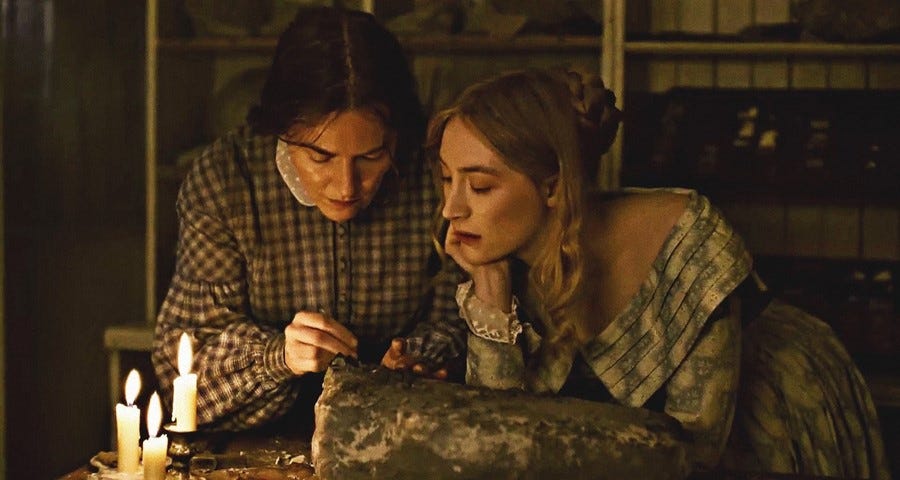
*
Trends and fears and fashion are all linked to anxiety.
In fact, the length of dresses and skirts throughout history are typically determined by economic anxiety: according to the skirt length theory, shorter hems are fashionable in times of economic success and excess (i.e. the flapper in the 1920s, the babydoll dress in the 1990s) and longer hems are fashionable in times of economic distress (i.e. longer dresses during the depression in the 1930s, the maxi-dress trend of the early 2010s post-recession).
Of course younger adults want to explore the tidy, cozy, slower way of living inherent in cottagecore. We’re mostly stuck inside still even if we’re vaccinated, existing solely on Zoom and TikTok, kept at a constant six-foot distance from everyone we love.
What might isolation look like in a beautiful, perfect, thoughtfully constructed world? Cottagecore is not merely copying Taylor Swift’s last few album aesthetics, but rather an understandable, if not always transparent, response to a nerve-wracking and wildly unpredictable future we’re all facing.

There’s nothing uncertain about taking a leisurely stroll around a pond, journaling in a lush green garden, or crafting needlepoint crafts in your spare time. All of these activities allow you control and a moment to focus on yourself.
What I was willing to invoke with my early 2010s look— those ~*mid-century vibes*~ —gave me control over what amounted to a quiet but very real rising tide of anti-feminist sentiment that I felt leading up to the 2016 election and the rise of the alt-right. It allowed me to feel powerful when little else could. It wasn’t hurting anyone: I just wasn’t 100% honest with myself about why this aesthetic appealed, and what darknesses I was willing to overlook.
We’re always looking for control to quell our fears: we’re just not always transparent about them, or perhaps aware of where they come from and how they manifest.


